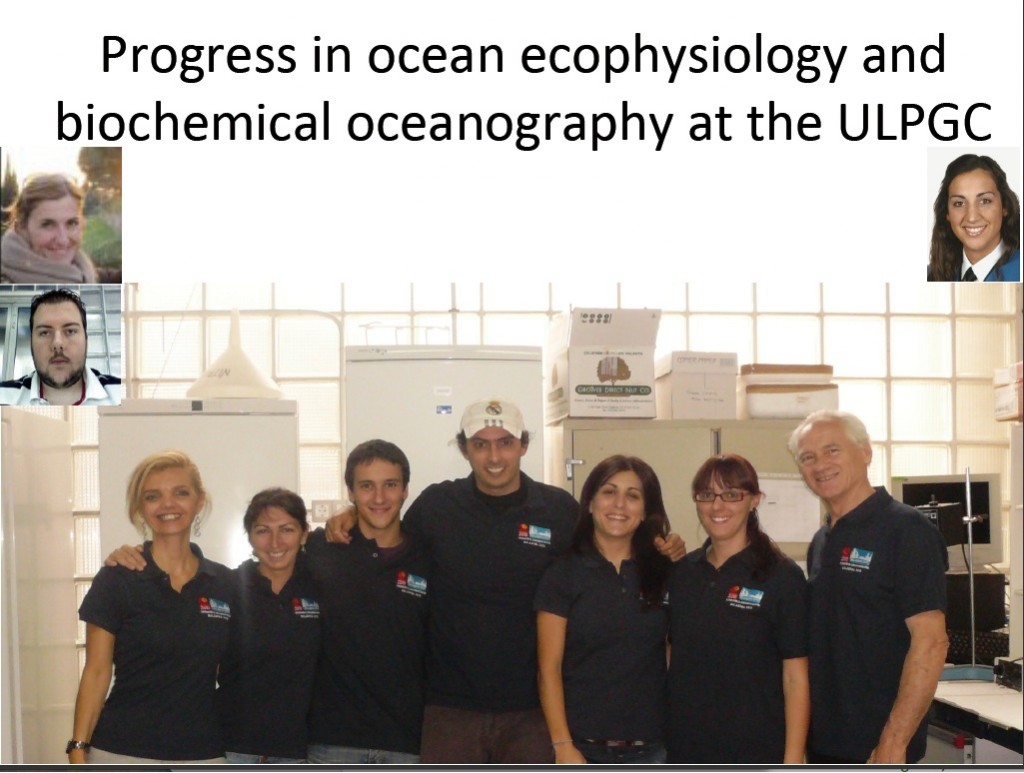Progress in ocean ecophysiology and biochemical oceanography at the ULPGC
Last week in the first KOSMOS-14 seminar, Ted reported on the latest activities of the ULPGC’s Plankton Ecophysiology group and showed how their research can be integrated into the KOSMOS-14 program. This group studies respiration, growth, nitrogen metabolism, and uses these primary measurements to calculate oceanic carbon flux, upper ocean nutrient retention efficiency, and deep ocean metabolism. It works with zooplankton, phytoplankton, bacteria, and macroalgae. The premise behind the group’s investigations is that enzyme biochemistry controls an organism’s physiology that, in turn, has a strong impact on ocean chemistry and ecology. This research team uses as foils, the metabolic theory of ecology (MTE) and Kleiber’s law to argue the fact that respiratory metabolism is controlled not by biomass, but by the respiratory electron transport system (R-ETS). It has pointed out that the reason, zooplankton respiration statistically correlates with biomass, is because biomass packages mitochondria and mitochondria package the R-ETS. It has demonstrated, experimentally with Artemia salina, the superiority of using ETS as a respiration proxy rather than using biomass. Working with bacteria it has shown the inadequacy of the MTE in describing respiration in different growth phases of bacteria and has shown that a rival model based on enzyme kinetics works much better.
Knowing that science leaps forward and whole new research fields open up when new methods are developed, this plankton ecophysiology group devotes significant effort to improving existing methods and to developing new ones. The group (PEG) has clarified the misunderstood chemistry behind R-ETS analysis and demonstrated the importance of understanding redox and organic chemistry before attempting to apply enzyme assays to oceanographic problems.
PEG studies growth and zooplankton secondary production. It has tested models of secondary production and has shown the inadequacy of some of them. PEG has been studying the suprabenthic zooplankton that live in the ocean’s nepheloid layer and the zooplankton that live in different fishing grounds around Mallorca. PEG members have made a comparison of the carbon flux as measured by sediment traps and as modeled from plankton respiration in the Namibian upwelling area. For the zooplankton south of the Canary Islands they have developed a carbon flux model to predict the carbon flux, associated with zooplankton, at any depth in the ocean water column. They have developed a new concept, the nutrient retention efficiency (NRE) that permits calculations of the percent of essential nutrients that are retained in the euphotic zone or in the epipelagic zone. PEG has adapted the R-ETS to the study of the macroalgae, Ulva. In addition, it has developed new insight into the currently debated topic of the heterotrophic-autotrophic status of the ocean. In the last year one PhD student and three masters students graduated from this research group. Currently the PEG consists of Prof. May Gomez, Graduate students, Alicia Herrera, Federico Maldonado, Natalia Osma, Igor Fernández, Mayte Tames, Vanesa Romero, Marine Technician, Ico Martinez, and Research Associate, Ted Packard. Eduardo Bru is assisting in the Kosmos-14 experiment as a member of the Master’s Program administration.
In the KOSMOS-14 experiment PEG will test its new methodology for measuring planktonic ETS, isocitrate dehydrogenase (IDH), and ammonium monooxidase (AMO) activities on two R/V Poseidon cruises between 22 and 27 February. Then, in the mesocosms, enriched with deep-sea nutrient-rich seawater, the PEG members will measure the time-courses of the activities and the kinetic constants of the plankton ammonium excretion enzyme, GDH, the plankton respiratory enzymes, ETS and IDH, and the microbial nitrification enzyme, AMO. In addition it will measure the physiological rates associated with these enzymes, namely ammonium excretion, respiratory O2 consumption and CO2 production, and ammonium oxidation. It expects all the protein-specific physiological rate processes to drop after the nutrients are exhausted in the mesocosms, but not the protein-specific enzyme activities nor the kinetic constants. With the time-course data the PEG members will test their enzyme kinetic model for predicting physiological rates. PEG intends to study the effect of varying CO2 and pH on all these biochemical parameters.
